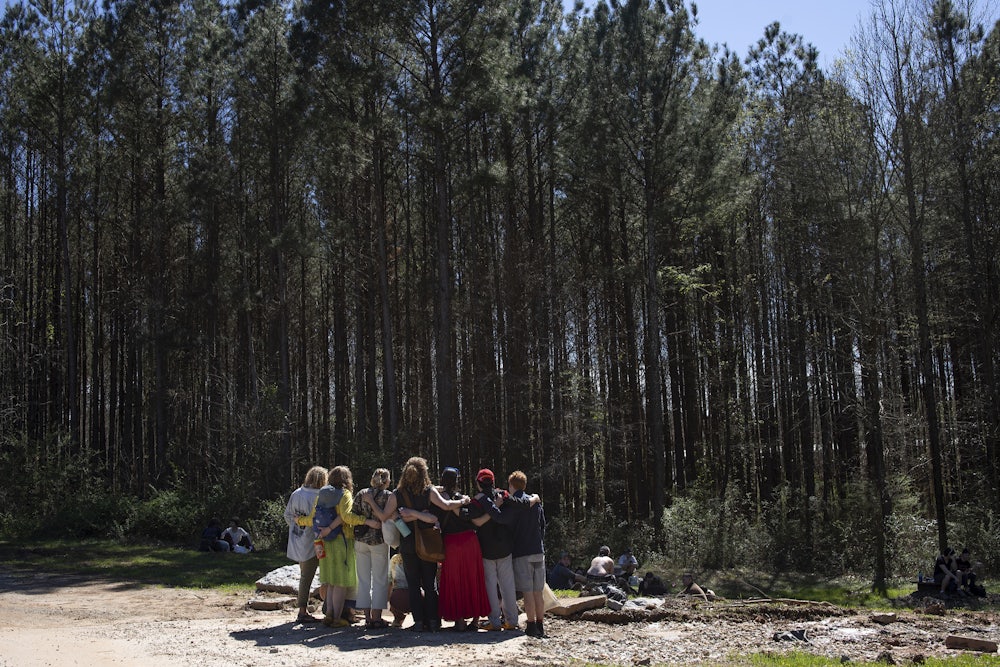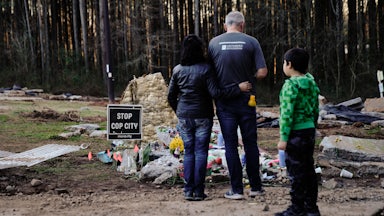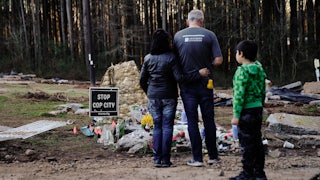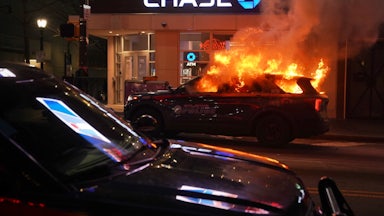Proponents of Atlanta’s “Cop City,” the massive police training academy scheduled to be built on land that overlaps with a beloved forest, claim that sacrificing this green space is a necessary crime-fighting measure.
In 2021, as crime surged in Atlanta—as it did in many other U.S. cities that year—Dave Wilkinson, president and CEO of the Atlanta Police Foundation, the group promoting and financially backing “Cop City,” made the case in an op-ed published by the Atlanta Journal-Constitution. The surge in crime after so many years of relative decline, he argued, showed “how fragile the fabric of public safety can be.” The Cop City project, he argued, was “the most important commitment our city had made to enhance public safety in 50 years.” Not too shy to evoke phallic imagery, Wilkinson described it as “seminal,” intended to address “soft” spots in the city’s law enforcement strategy. “Everyone agrees that we need action now to stem the rising tide of crime,” he emphasized, arguing that Cop City was essential to reducing Atlanta’s crime problem.
Two years later, police and protesters are waging an intense public battle over whether Cop City should be built in Atlanta’s Weelaunee Forest. Britain’s Daily Mail, calling the protesters “extremists,” found a nearby resident to interview at great length, who summed it up like this: “People are trying to find the sweet spot between saving the earth and stopping the maniacs with the automatic rifles.”
The problem with this view is that it positions environmentalism and safety as opposing interests. Recent events have offered a painful reminder that some dangerous “maniacs” wear blue: Though there have been several aggressive confrontations between protesters and police in the forest, only the police have killed anyone. Protester Manuel Páez Terán was killed in January, and while police claimed Terán shot at an officer first, last week their family released the results of an autopsy showing that Terán was sitting down with their hands raised when they were shot. Camera and audio footage of interactions leading up to the tragedy released last month seems to suggest that the police officer was shot by another officer, as some activists present have also said.
But the danger posed by police even to nonviolent protesters isn’t the only problem with pitting “saving the earth” against fighting crime. It’s a false binary: Atlanta residents don’t have to choose between forests and strengthening what Wilkinson calls the “fragile” fabric of public safety. A large body of research shows that green spaces, especially when well maintained and heavily used, reduce urban crime.
Last year, a study conducted by a team of scholars, some from public safety departments and some from environmental studies, reviewed 10 years of precinct-level data in South Africa, where violent crime is a huge problem. After controlling for income, unemployment, and a range of other important factors, they found that for every 1 percent increase in green space, there was a 1.2 percent decrease in violent crime and a 1.3 percent decrease in property crime. Another study, also published last year, analyzed data in 300 cities in the U.S. with similar results.
Some researchers report a more nuanced finding: Sometimes crime takes place in green spaces. We’ve all been warned not to walk alone in certain parks, and sometimes those admonitions are justified. University of Virginia researchers found in 2020 that green space that was badly designed or poorly maintained could increase crime, but when parks or forests were well designed and cared for, they decreased crime. Equally compellingly, a 2021 study, using cell phone data to track people in Chicago and New York City, found that while a decrease in crime was only loosely related to the presence of nearby parks, residents’ use of parks—playing sports, hanging out with friends, going for walks, bird watching—had a much more dramatic impact on crime. In Chicago, a 25 percent increase in park visits in an area was associated with a 6.8 percent decrease in violent crime (5.7 percent in New York City).
It would be easy to assume that parks are a proxy here for “having nice things for young people to do.” But the benefits of green space seem to go beyond wholesome amusement: The 2021 study of Chicago and New York City also measured museum use and found no impact on crime (sorry, fans of art and culture).
So it’s clear that preserving—or creating—well-tended green spaces that people want to use will strengthen what Wilkinson calls the “fragile” fabric of public safety. Everyone wants to live in a society with less crime and more green space, and there is no reason why the residents of Atlanta, and all of us, cannot have both.
A constant drumbeat of “copaganda”— the messages picked up by the media advancing the perspective of the police—insists that a militarized police force terrorizing a neighborhood with simulations and gunshots is worth the sacrifice of a forest to fight crime. But what if the forest defenders—many of whom are facing draconian charges of “terrorism” now—are the true protectors of public safety? Instead of militarizing their police forces, cities should be creating more forests, caring for them, and saving the ones we have.










